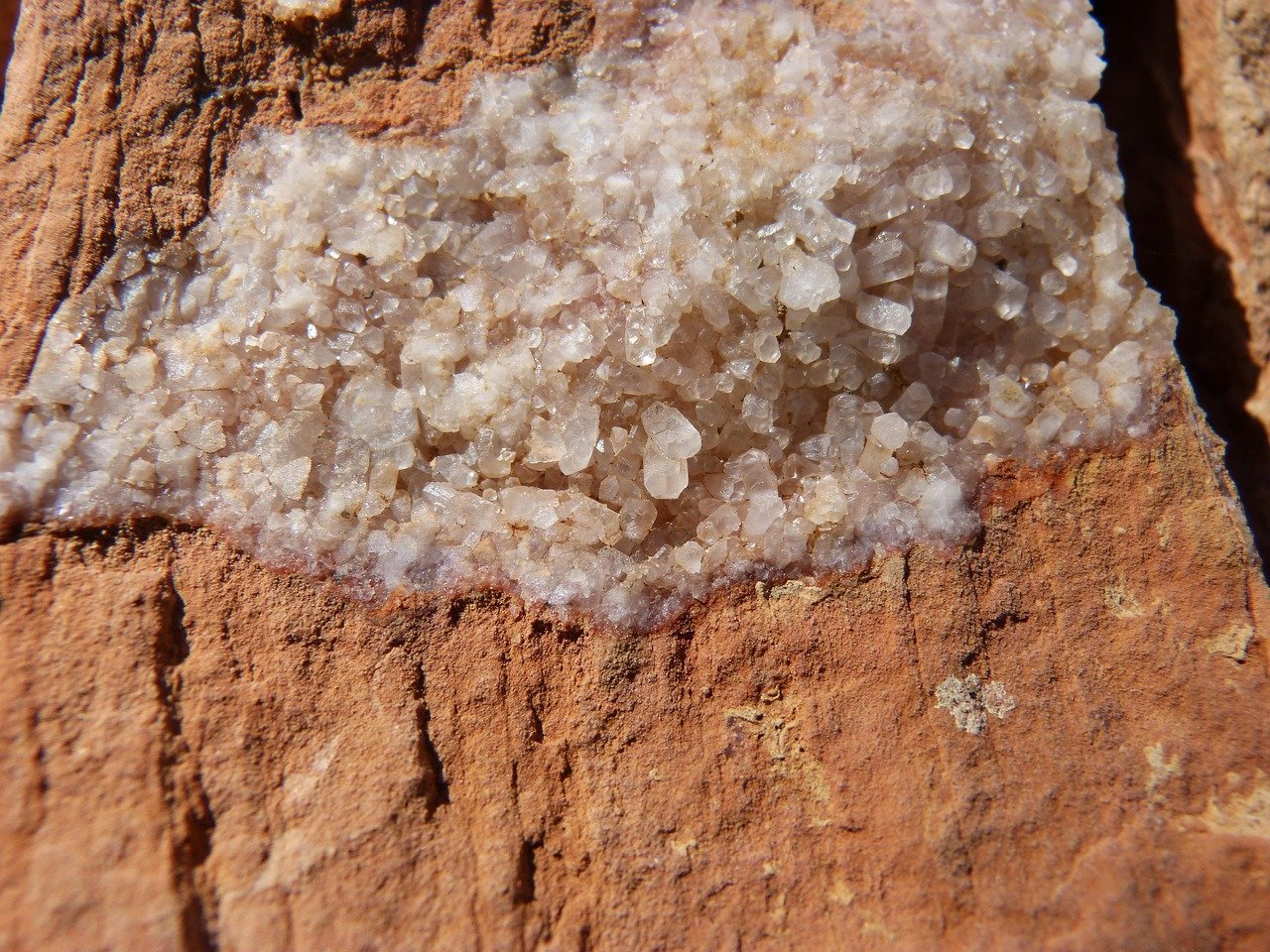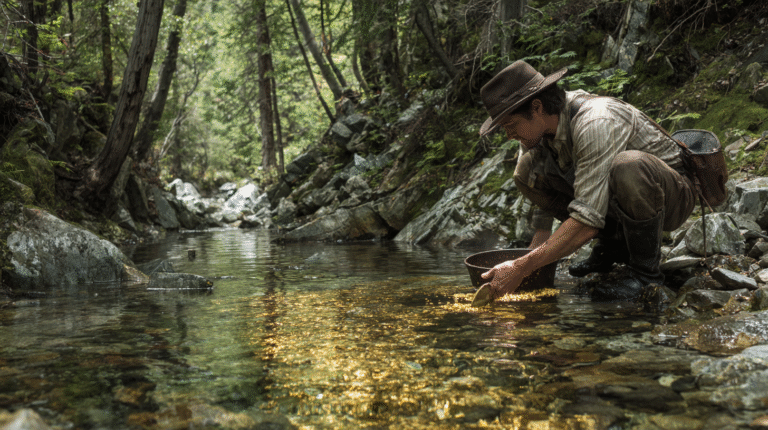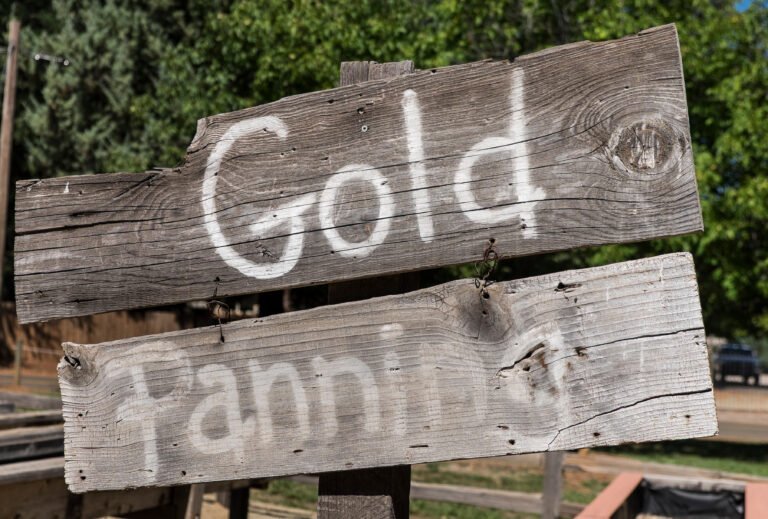Gold prospecting can be an exciting and rewarding adventure.
To increase your chances of finding gold deposits, it’s essential to understand the indicators that can lead you to the precious metal.
One of the key factors to consider is the type of rocks present in an area.
Various rocks can serve as indicators of gold and provide valuable clues for prospectors.
These rocks include quartz, granite, slate, basalt, schist, and even iron pyrite.
Each rock type has distinct characteristics and geological formations that make them more likely to contain gold.
Key Takeaways:
- Quartz, granite, slate, basalt, schist, and iron pyrite are rocks commonly associated with gold deposits.
- Gold-bearing quartz, known as auriferous quartz, is often found in hard rock deposits.
- Granite can contain gold-bearing quartz veins alongside fine grains of gold.
- Slate may contain gold deposits in thin faults and cracks, but it is relatively uncommon.
- Basalt, under specific conditions of hydrothermal activity, can bear gold in greenstone belts.
Quartz
Quartz is one of the most common rocks associated with gold deposits. Gold in quartz, also known as auriferous quartz, is often found in hard rock formations.
The gold is present in a metallic form and is contained within the crystalline structure of the quartz.
Alluvial deposits, where gold settles in waterways, are often found downstream from quartz formations.
Quartz with gold can be easily processed by crushing the quartz and extracting the gold. This makes it a valuable rock for gold prospecting.
In fact, famous gold deposits associated with quartz include those that sparked the California Gold Rush.
The presence of gold-bearing quartz is a significant indicator for potential gold deposits.
Properties of Gold-Bearing Quartz:
- Gold is in a metallic form within the quartz
- Often found in hard rock formations
- Commonly associated with alluvial deposits
Crushing and Extracting Gold from Quartz:
- Crush the quartz to release the gold
- Extract the gold using various methods such as panning or using specialized equipment
Gold in quartz is a treasure waiting to be discovered. Prospectors who recognize the significance of gold-bearing quartz have a greater chance of striking gold in their search for precious metals.
Granite
Granite is a coarse-grained igneous rock that can contain gold-bearing quartz veins.
These veins are sought out by miners due to their higher gold content.
The surrounding granite may also contain fine grains of gold. However, extracting gold from granite requires chemical processing with cyanide.
Granite deposits are often used in areas where auriferous quartz has already been mined out.
Checking for the presence of quartz and iron oxides can help identify gold-bearing granite.
| Granite Properties | Gold Content |
|---|---|
| Coarse-grained igneous rock | May contain gold-bearing quartz veins |
| Requires chemical processing with cyanide for gold extraction | May contain fine grains of gold |
| Commonly used in areas where auriferous quartz has been mined out | – |
- Granite is a coarse-grained igneous rock that can contain gold-bearing quartz veins.
- The gold content in granite makes it an attractive target for miners.
- Chemical processing with cyanide is needed to extract gold from granite.
- Fine grains of gold may also be present in the surrounding granite.
- Granite deposits are often used in areas where auriferous quartz has already been mined out.
“Granite deposits have been significant sources of gold, especially when associated with quartz veins.” – Mining Expert
Identifying Gold-Bearing Granite
To identify gold-bearing granite, prospectors should look for the presence of quartz and iron oxides.
Quartz veins running through the granite indicate the potential for gold deposits.
Iron oxides, such as hematite or magnetite, can also serve as indicators of gold-bearing granite.
By recognizing these geological features, prospectors can increase their chances of finding valuable gold deposits within granite formations.
Slate
Slate, a metamorphic form of shale, can contain gold deposits in thin faults and cracks.
Rusty streaks in slate often indicate larger amounts of iron deposition, which can be a sign of gold presence.
However, auriferous slate is relatively uncommon compared to other rock types.
The Carolina Slate Belt and Sierra Nevadas of California are the primary areas where gold-bearing slate has been exploited.
Auriferous Slate Deposits
The presence of gold in slate is typically associated with narrow faults and cracks within the rock.
These fissures provide pathways for hydrothermal fluids, which can carry gold from deeper sources to shallower depths.
As these fluids cool and solidify, gold can deposit along the fractures, resulting in the formation of gold-bearing slate.
However, it is important to note that the occurrence of auriferous slate is not as widespread as other gold-bearing rock types.
One significant region known for its gold-bearing slate is the Carolina Slate Belt in the eastern United States.
This geological formation stretches across parts of Virginia, North Carolina, South Carolina, and Georgia.
The belt is characterized by a series of slate and schist rocks that have undergone intense metamorphism.
Gold deposits in the Carolina Slate Belt are often found in close association with quartz veins and sulfide minerals.
Another notable area for gold-bearing slate is the Sierra Nevadas of California.
The California Gold Rush in the mid-1800s saw thousands of prospectors flocking to this region in search of gold.
While the majority of the gold deposits were associated with auriferous quartz veins, gold-bearing slate was also mined.
The slate in the Sierra Nevadas contains iron sulfide minerals, which can indicate the presence of gold.
The gold in this region is often fine-grained and can be extracted through various mining techniques.
Comparison of Gold-Bearing Rock Types
| Rock Type | Main Characteristics | Common Locations |
|---|---|---|
| Quartz | Contains auriferous quartz veins | California, Australia, South Africa |
| Granite | Often associated with gold-bearing quartz veins | Canada, Alaska, Colorado |
| Slate | Can contain gold deposits in thin faults and cracks | Carolina Slate Belt, Sierra Nevadas (California) |
| Basalt | Gold deposits occur under specific hydrothermal conditions | Australia, Canada |
| Schist | Gold often located along shear zones and quartz veins | New Zealand, Finland, Virginia |
| Iron Pyrite | Sulfide mineral often associated with gold | Various locations worldwide |
Slate may not be as commonly recognized as quartz or granite when it comes to gold prospecting.
However, understanding its potential as a gold-bearing rock can provide valuable insights for prospectors exploring regions such as the Carolina Slate Belt and the Sierra Nevadas.
Prospectors should look for signs such as rusty streaks and associated sulfide minerals to increase their chances of finding gold in slate formations.
Basalt (Greenstone)
Basalt, an igneous rock, has the potential to bear gold under specific conditions.
The presence of gold deposits in basalt relies on two main factors: hydrothermal activity and cracking of the rock.
These conditions create pathways for gold to be transported and deposited within the basalt.
One noteworthy type of basalt associated with gold is greenstone.
Greenstone belts, characterized by their green-colored rocks due to copper and chlorite-bearing minerals, can be indicators of the presence of gold in basalt formations.
The presence of copper and chlorite in greenstone belts creates favorable conditions for gold deposition within the basalt.
It is important to note that while gold-bearing basalt exists, it is more commonly found in regions like Australia and Canada, where extensive greenstone belts can be found.
These regions have seen significant gold mining activities associated with auriferous basalt deposits.
Schist
Schist is a metamorphic rock that can contain gold, particularly greenschist.
Gold in schist is often located along shear zones, where rocks have deformed or broken. Quartz veins in schist can also be associated with gold deposits.
However, finding gold in schist requires knowledge of known veins and is not as common as other rock types.
Gold-bearing schist has been found in various places worldwide, including New Zealand, Finland, and Virginia.
“Schist is an intriguing rock formation that can hold the secret to hidden gold deposits. Its unique structure and mineral composition make it a potential hotspot for gold prospecting.” – John Smith, Geologist
When it comes to gold-bearing rocks, schist is often overlooked but shouldn’t be underestimated.
Its distinctive characteristics, such as its foliated texture and high metamorphic grade, can create favorable conditions for gold mineralization.
While it may not be as prevalent as quartz or granite, schist still holds the potential for significant gold discoveries.
Shear Zones: Schist’s Gold Traps
The formation of gold deposits in schist is closely linked to shear zones.
Shear zones are areas where rocks have undergone intense deformation due to tectonic forces, resulting in fractures and faults.
These zones can create conduits for mineral-rich fluids, including gold-rich solutions, to migrate and accumulate within the schist.
As the rocks deform, the pressure and heat generated can cause the mineral-rich fluids to be squeezed along the shear zones, depositing gold and other minerals.
These shear zones often display visible signs of deformation, such as folding, faulting, and fractures, which can guide prospectors to potential gold-bearing schist formations.
Quartz Veins in Schist: A Promising Indicator
Another significant indicator of gold in schist is the presence of quartz veins.
Quartz veins can form when mineral-rich fluids flow through fractures in the schist, leaving behind quartz and potentially other minerals, including gold.
These veins can serve as pathways for gold deposition, indicating the presence of gold-bearing schist formations.
Prospectors should carefully examine schist formations for visible quartz veins, as they can lead to the discovery of significant gold deposits.
The combination of shear zones and quartz veins within schist provides valuable clues for successful gold prospecting in these rock formations.
Gold-Bearing Schist: Global Discoveries
The presence of gold-bearing schist has been documented in various regions worldwide, offering exciting opportunities for gold prospectors:
- New Zealand: The Otago region in New Zealand is renowned for its gold-bearing schist formations. The rich deposits in Central Otago have attracted significant attention from prospectors and have historically produced substantial gold yields.
- Finland: The Finnish Lapland region hosts gold-bearing schist formations, particularly in the Kittilä greenstone belt. These schist formations have contributed to Finland’s growing gold production.
- Virginia, United States: The schist formations in the Central Virginia Gold Belt have been a source of gold for centuries. The iconic gold mines in the region have continuously yielded significant amounts of gold from auriferous schist.
Gold-bearing schist offers the potential for lucrative gold discoveries, provided prospectors are equipped with the right knowledge and techniques.
While it may require a more targeted approach compared to other rock types, the rewards of finding gold in schist can be substantial.
Iron Pyrite (“Fool’s Gold”)
Iron pyrite, also known as “Fool’s Gold”, is a sulfide mineral that is often associated with gold.
While it may be mistaken for gold due to its appearance, iron pyrite can actually contain small amounts of gold.
Native gold deposits and pyrite are formed under similar conditions of underground hydrothermal activity.
Recent studies have found gold hosted in tiny faults within iron pyrite crystals.
However, extracting gold from iron pyrite is still a challenge.
If we take a closer look at iron pyrite, we’ll find that it shares a striking resemblance to gold. Its golden color and metallic luster contribute to the confusion.
However, the mineral composition of iron pyrite and gold are quite different.
“Although it’s called ‘Fool’s Gold,’ iron pyrite plays an important role in prospecting. Its association with gold indicates the potential presence of gold deposits nearby.” – Mining Expert
Iron pyrite is a sulfide mineral composed of iron and sulfur (FeS2). On the other hand, gold is a precious metal with the elemental symbol Au.
Despite their differences, iron pyrite often occurs in the same geological environments where gold is found.
This is due to the similar processes that form both minerals.
Researchers have discovered that tiny faults within iron pyrite crystals can host gold.
These gold particles form due to hydrothermal activity, which creates ideal conditions for both iron pyrite and gold to precipitate from fluid-rich solutions.
The presence of iron pyrite can serve as a useful indicator for prospectors searching for gold.
However, it’s important to note that even though iron pyrite may contain small amounts of gold, the concentration is typically low.
Extracting gold from iron pyrite is a complex and costly process, usually not economically viable.
Despite its limited value in terms of gold extraction, iron pyrite remains a fascinating mineral with its intriguing association with gold.
Its golden appearance may deceive, but the clues it provides to the presence of gold deposits make it an essential tool for prospectors.

Disclosure: This Post Contains Affiliate Links; We earn a commission on purchases.
Signs to Look Out for When Prospecting
When prospecting for gold, there are several signs to look out for that can help you identify potential gold deposits.
Paying attention to these signs can greatly increase your chances of finding gold. Let’s explore some of the most important indicators to keep an eye on:
Changes in Rock Types
One of the key geologic indicators of gold is changes in rock types. Different rock formations can provide clues about the presence of gold.
For example, the occurrence of quartz, granite, slate, basalt, schist, and iron pyrite in an area can suggest the potential for gold deposits.
By familiarizing yourself with these rock types and understanding their association with gold, you can narrow down your search and focus on areas with a higher likelihood of finding gold.
Soil Color Changes
Another sign to watch out for is changes in soil color. Gold can impact the color of the soil, especially in areas where it is close to the surface.
Look for reddish or yellowish soil, which may indicate the presence of oxidized iron minerals associated with gold.
These color changes can help you identify areas where gold might be found and guide your prospecting efforts.
Presence of Iron Staining
Iron staining is yet another indicator of potential gold deposits. Iron minerals often occur in association with gold, and their presence can leave visible staining on rocks and soil.
Look for reddish or orange discoloration, which can suggest the occurrence of iron-rich minerals and the potential for nearby gold deposits.
FAQ
Q: What rocks indicate gold?
A: Gold can be found in various types of rocks, including quartz, granite, slate, basalt, schist, and even iron pyrite. These rocks have different characteristics and formations that make them more likely to contain gold.
Q: What is gold-bearing quartz?
A: Gold-bearing quartz, also known as auriferous quartz, is quartz containing gold in its metallic form. It is often found in hard rock deposits and can be processed by crushing the quartz to extract the gold.
Q: Can granite contain gold?
A: Yes, granite can contain gold-bearing quartz veins, which are sought out by miners due to their higher gold content. The surrounding granite may also contain fine grains of gold.
Q: Is slate associated with gold deposits?
A: While gold-bearing slate is relatively uncommon compared to other rock types, it can contain gold deposits in thin faults and cracks. Rusty streaks in slate often indicate larger amounts of iron deposition, which can be a sign of gold presence.
Q: Can basalt indicate the presence of gold?
A: Yes, basalt may bear gold under specific conditions, such as hydrothermal activity and cracking. Greenstone belts, characterized by green-colored rocks, can indicate the presence of gold in basalt.
Q: Does schist contain gold?
A: Yes, schist can contain gold, particularly greenschist. Gold in schist is often located along shear zones, where rocks have deformed or broken. Quartz veins in schist can also be associated with gold deposits.
Q: Can iron pyrite indicate the presence of gold?
A: Yes, iron pyrite, also known as “Fool’s Gold,” is often associated with gold. While it may be mistaken for gold due to its appearance, it can actually contain small amounts of gold. Recent studies have found gold hosted in tiny faults within iron pyrite crystals.
Q: What signs should I look for when prospecting for gold?
A: When prospecting for gold, look out for changes in rock types, soil color, iron staining, eroding rocks, and the occurrence of various minerals. These can all indicate the presence of gold in an area.
Q: What are some geologic indicators of gold?
A: Geologic indicators of gold include rock-type changes, soil color changes, iron staining, eroding rocks, and the presence of various minerals, especially those associated with gold.
Q: How can I increase my chances of finding gold?
A: By understanding the indicators of gold, such as specific rock types and geological changes, prospectors can increase their chances of finding gold deposits. Paying attention to signs like rock-type changes, soil color changes, iron staining, eroding rocks, and the presence of gold-associated minerals can help in the search for gold.
Source Links
- https://rockseeker.com/rocks-that-contain-gold/
- https://www.minelab.com/community/treasure-talk/eight-natural-geologic-signs-pointing-toward-gold
- https://www.prospectorspatch.com.au/5-signs-to-check-for-gold-pieces-in-rocks-our-prospecting-guide/
Conclusion
Gold prospecting is an art that requires a combination of geological knowledge, prospecting skills, and experience.
By understanding the indicators of gold, such as specific rock types and geological changes, prospectors can greatly enhance their chances of finding gold deposits.
Quartz, granite, slate, basalt, schist, and iron pyrite are some of the rocks commonly associated with gold.
When prospecting for gold, it is crucial to watch out for certain signs.
Changes in rock types, soil color variations, the presence of iron staining, eroded rocks, and the occurrence of specific minerals can all serve as valuable indications of potential gold deposits.
These geologic indicators can guide prospectors to the right areas where gold may be found.
By paying careful attention to these signs, prospectors can increase their chances of success and have a more fruitful gold prospecting experience.
Armed with knowledge and a keen eye for gold indicators, prospectors can embark on their adventures with confidence, knowing they are equipped with the tools necessary to uncover this precious metal.

Meet Ryan Conlon, the passionate owner and driving force behind Pan for Treasure.
With an unwavering love for the art of gold panning, Ryan has transformed his enthusiasm into a thriving community hub for fellow treasure seekers. [email protected]
A seasoned gold panning enthusiast, Ryan’s journey began with a simple pan and a dream, evolving into a deep appreciation for the history, geology, and thrill of uncovering precious metals.
Subscribe to Our Newsletter







